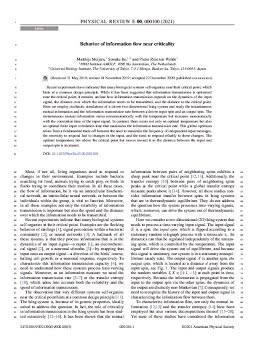2021-01-27
Behavior of information flow near criticality
Publication
Publication
Phys. Rev. E , Volume 103 - Issue 1 p. L010102 : 1- 5
Recent experiments have indicated that many biological systems self-organize near their critical point, whichhints at a common design principle. While it has been suggested that information transmission is optimizednear the critical point, it remains unclear how information transmission depends on the dynamics of the inputsignal, the distance over which the information needs to be transmitted, and the distance to the critical point.Here we employ stochastic simulations of a driven two-dimensional Ising system and study the instantaneousmutual information and the information transmission rate between a driven input spin and an output spin. Theinstantaneous mutual information varies nonmonotonically with the temperature but increases monotonicallywith the correlation time of the input signal. In contrast, there exists not only an optimal temperature but alsoan optimal finite input correlation time that maximizes the information transmission rate. This global optimumarises from a fundamental trade-off between the need to maximize the frequency of independent input messages,the necessity to respond fast to changes in the input, and the need to respond reliably to these changes. Theoptimal temperature lies above the critical point but moves toward it as the distance between the input andoutput spin is increased.
| Additional Metadata | |
|---|---|
| American Physical Society (APS) | |
| Netherlands Organisation for Scientific Research (NWO) | |
| doi.org/10.1103/PhysRevE.103.L010102 | |
| Phys. Rev. E | |
| Organisation | Biochemical Networks |
|
Meijers, M., Ito, S., & ten Wolde, P. R. (2021). Behavior of information flow near criticality. Phys. Rev. E, 103(1), L010102 : 1–5. doi:10.1103/PhysRevE.103.L010102 |
|
